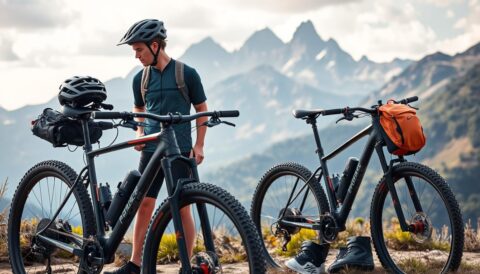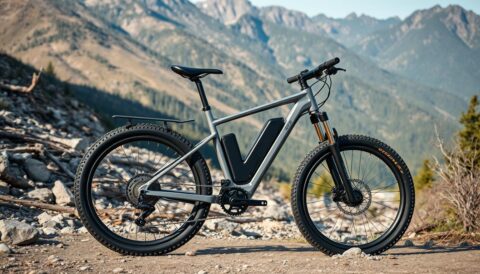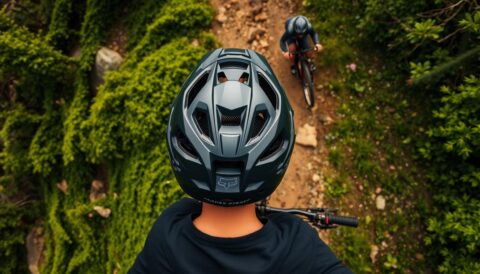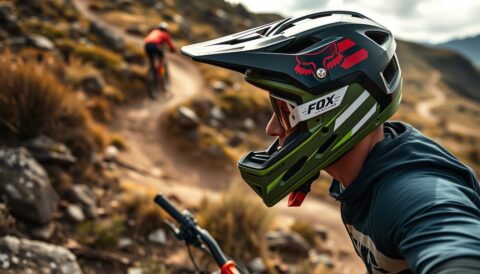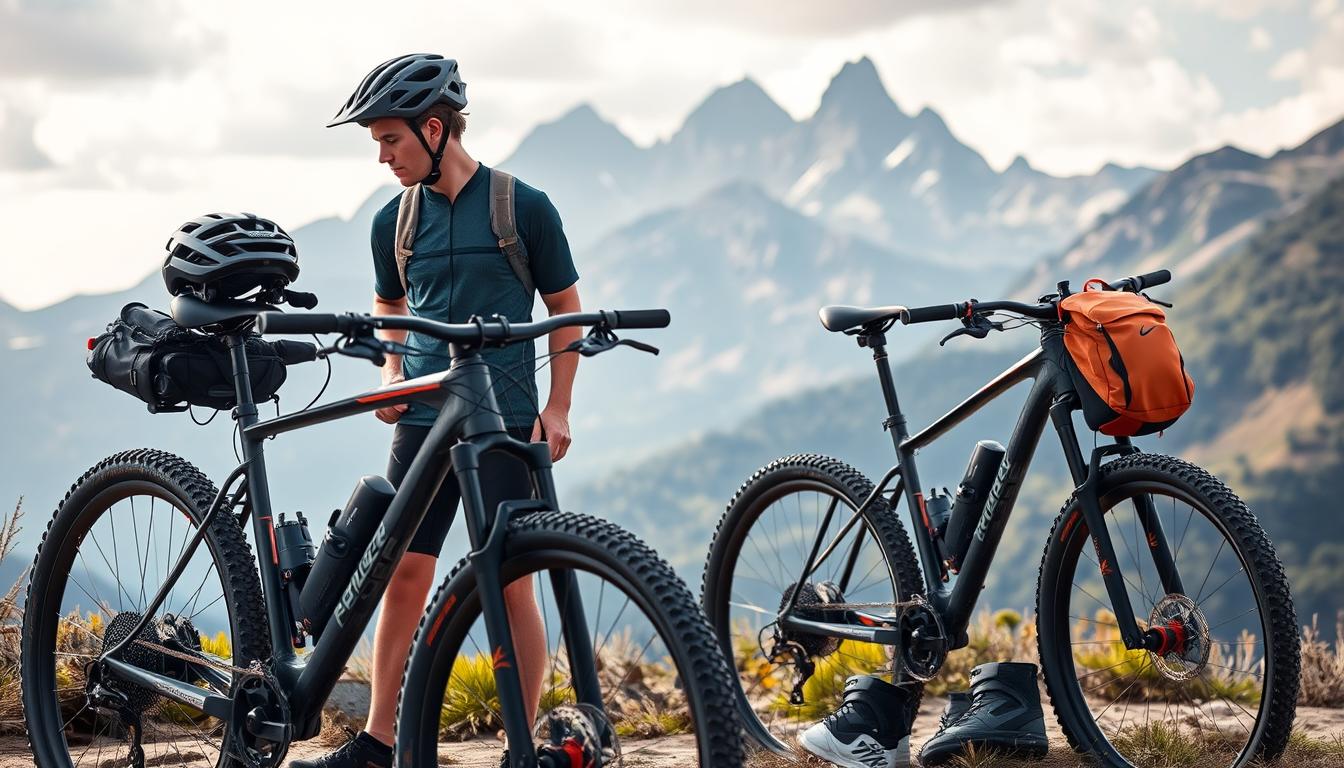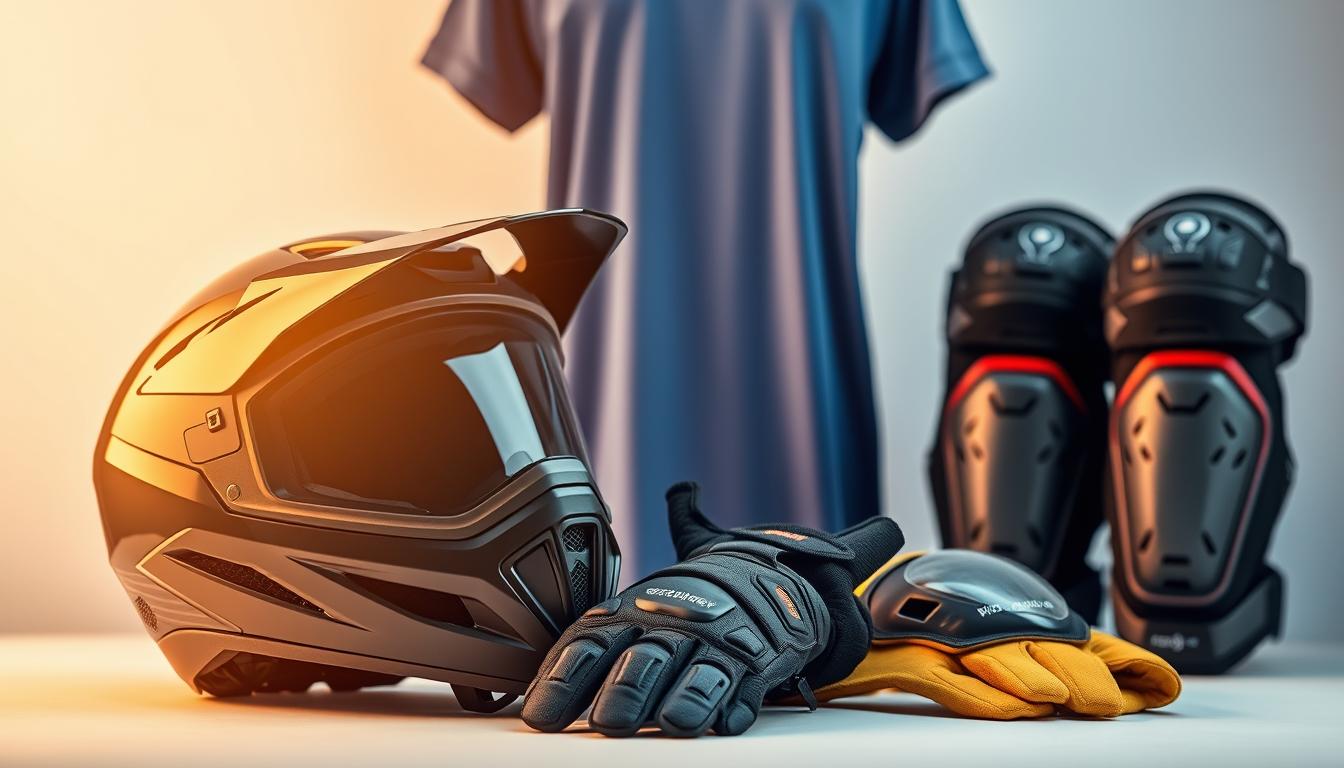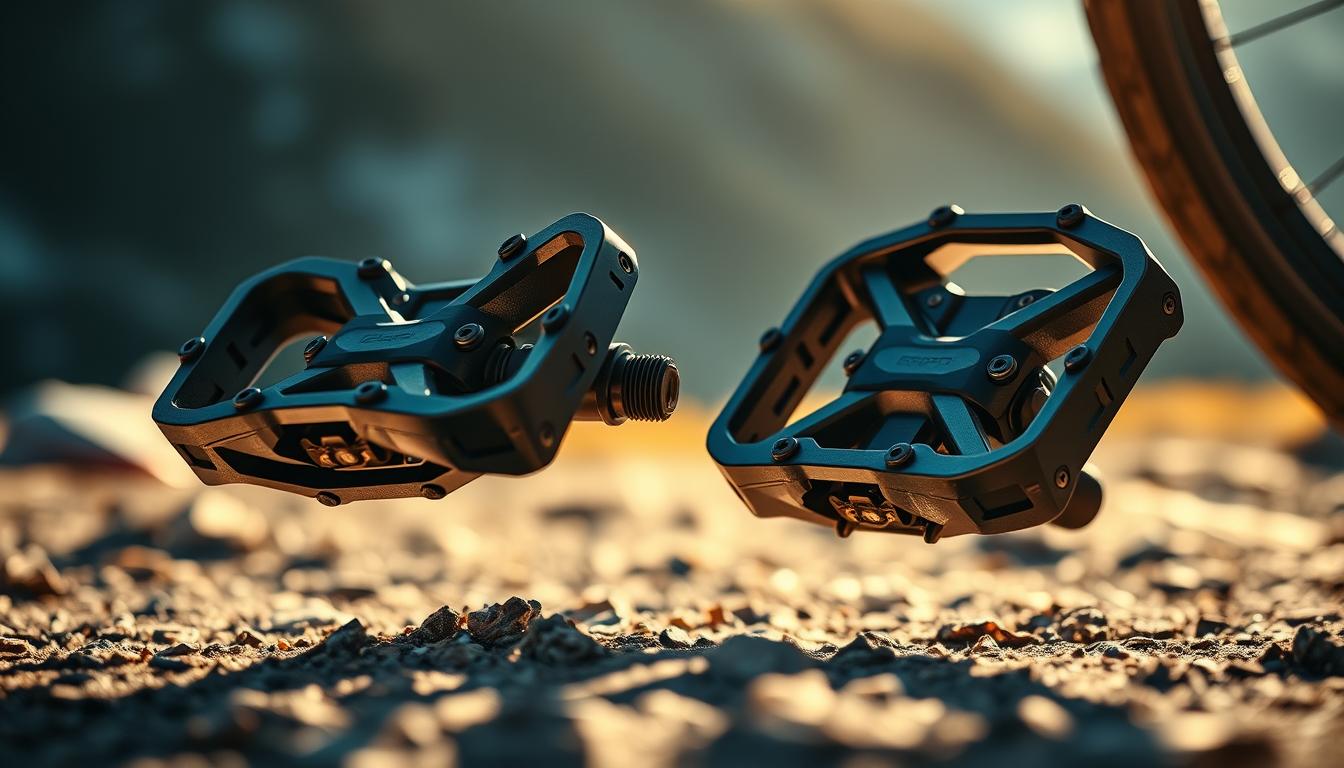When it comes to e-mountain biking, safety and comfort are paramount. A quality helmet is not just an accessory; it’s a vital piece of safety gear that can make all the difference on your adventures. Whether you’re tackling challenging trails or enjoying a leisurely ride, the right helmet ensures protection without compromising on style or comfort.
In this buyer’s guide, we’ll explore the best options available, featuring top-rated helmets from renowned brands like Troy Lee Designs, Fox, Giro, and more. We’ll dive into key features such as impact protection, ventilation, and design, helping you make an informed decision. For instance, the Giro Manifest Spherical stands out with its exceptional ventilation, scoring a 10.0 in this category1.
Our detailed review includes insights from industry testing and user feedback, ensuring you get a comprehensive overview. We’ll also discuss technologies like MIPS and how they enhance safety. Whether you’re a seasoned rider or just starting out, this guide will help you find the perfect blend of style, design, and protection for your next e-mountain biking excursion.
Introduction to E-Mountain Bike Helmets
E-Mountain biking presents unique challenges, making a helmet essential for every ride. Unlike standard cycling helmets, e-mountain bike helmets are designed to offer enhanced protection for higher speeds and rugged terrains. These helmets must meet specific safety standards, such as the NTA-8776 certification, which ensures they can withstand impacts at speeds up to 27.9 miles per hour2.
When choosing a helmet, fit is crucial. A well-fitting helmet ensures optimal protection and comfort. Additionally, features like MIPS technology are vital for reducing rotational forces during an impact, enhancing overall safety3.
The price of e-mountain bike helmets varies, with quality options ranging from $100 to $300. While higher-priced models offer advanced features, even mid-range helmets provide excellent value. Your riding style and terrain will influence your choice, whether you prefer lightweight designs for cross-country trails or full-face helmets for downhill adventures.
Key Features of the best E-MTB Helmets
When selecting an e-mountain bike helmet, several key features ensure safety, comfort, and performance. High-quality helmets often include advanced materials like EPS foam, which absorbs impact effectively, and dual-density liners that offer superior protection4.
Ventilation systems are another crucial aspect, especially for long rides. These systems are designed to keep your head cool and reduce sweat buildup. For instance, the POC Kortal Race MIPS features excellent airflow, making it ideal for endurance rides5.
| Feature | Details | Examples |
|---|---|---|
| EPS Construction | Enhances impact absorption | POC Kortal Race MIPS |
| Dual-Density Liner | Provides optimal protection | Giro Manifest Spherical |
| Advanced Ventilation | Improves comfort during long rides | Bollé Avio MIPS |
Integrated MIPS systems are now common in many helmets, reducing rotational forces during impacts. This technology, combined with a secure retention system, ensures a snug fit and added safety. Every detail, from the liner to the ventilation, contributes to the helmet’s overall performance and safety.
For more information on top-tier models, visit MET Helmets to explore their range of high-performance e-mountain bike helmets.
Helmet Safety and Impact Protection
Impact protection is the cornerstone of any e-mountain bike helmet, ensuring rider safety during collisions. Modern helmets are designed to absorb and dissipate impact forces through advanced materials and engineering. The use of EPS foam and specially engineered liners plays a crucial role in collision force absorption, while the structural design helps distribute impact across the helmet’s surface6.
Features like dense outer shells further enhance protection by providing a robust barrier against impacts. Helmets such as the Giro Manifest Spherical and the Fox Dropframe Pro exemplify excellent impact protection, with the latter achieving a perfect 10/10 rating7. Additionally, technologies like MIPS (Multi-directional Impact Protection System) are integral in reducing rotational forces during impacts, adding another layer of safety8.
| Feature | Details | Examples |
|---|---|---|
| EPS Foam | Absorbs impact effectively | Giro Manifest Spherical |
| Dual-Density Liner | Provides superior protection | Fox Dropframe Pro |
| MIPS Technology | Reduces rotational forces | POC Kortal Race MIPS |
Independent safety ratings, such as the NTA-8776 certification, ensure helmets meet rigorous testing standards, particularly for higher speeds and weights associated with e-bikes7. Modern helmets also incorporate rear protection, offering comprehensive coverage for the back of the head, which is vital for riders who may fall backwards. This holistic approach to safety underscores the importance of selecting a helmet that meets both current standards and real-world demands.
The Role of MIPS Technology in Helmet Design
MIPS (Multi-directional Impact Protection System) is a revolutionary technology designed to enhance safety in helmets by reducing rotational forces during impacts. This system is particularly crucial for e-mountain biking, where riders often experience oblique impacts9.
Understanding MIPS
MIPS works by incorporating a slip plane within the helmet, allowing the inner layer to move slightly during an impact. This movement redirects rotational forces away from the head, significantly reducing the risk of brain injury. The system is integrated with other safety features like EPS foam to provide comprehensive protection9.
Benefits and Limitations
The benefits of MIPS are clear: it enhances safety by mitigating rotational forces, with some studies showing a reduction in injury risk by up to 30%9. However, some users note that the MIPS liner can cause slight noise and add minimal weight to the helmet. Despite these trade-offs, MIPS technology has become more affordable, with helmets available from £459.
Leading brands like Giro and Bell offer MIPS-equipped helmets, such as the Giro Helios Spherical and Bell Avenue MIPS, which blend safety with style. These helmets have received high ratings from Virginia Tech, further validating their effectiveness9.
Ventilation and Comfort for Long Rides
Proper ventilation is essential for keeping your head cool and comfortable during long e-mountain bike rides. A well-designed ventilation system ensures that heat and sweat don’t build up, which can be uncomfortable and distracting. Helmets with efficient ventilation systems are particularly important for endurance and cross-country riding, where maintaining a steady pace over extended periods is crucial.
Advanced Airflow Designs
Modern helmets feature advanced airflow designs that maximise cooling. These designs typically include large intake and exhaust vents, which create a consistent flow of air through the helmet. For example, the Bell Sixer MIPS has 13 large vents, which are strategically placed to draw in cool air and expel warm air10. This design ensures that the head stays cool even during intense efforts.
The internal channels within the helmet also play a critical role in directing airflow. These channels are carefully engineered to guide cool air over the head, while allowing warm air to escape. This not only improves comfort but also helps to prevent overheating, which can lead to fatigue and reduced performance.
Managing Heat and Sweat
Heat and sweat management are vital for maintaining comfort during long rides. Helmets with superior ventilation systems help to wick away sweat and prevent it from dripping into your eyes. This is especially important for riders who wear glasses or goggles, as sweat can obscure vision and create discomfort.
In addition to ventilation, the overall weight of the helmet contributes to comfort. Lighter helmets reduce the strain on the neck and shoulders, allowing riders to maintain their position for longer without fatigue. For instance, the Giro Manifest Spherical weighs approximately 370 grams, making it an excellent choice for riders seeking a lightweight yet protective option10.
When choosing a helmet, it’s important to consider both ventilation and fit. A helmet that fits securely and provides adequate airflow will enhance your riding experience. Additionally, practical tips like adjusting the fit system, using a sweatband, or taking regular breaks can help manage heat and sweat effectively.
Perfecting Fit: Retention Systems and Adjustability
A proper fit is essential for both safety and performance when it comes to e-mountain bike helmets. A well-fitting helmet ensures optimal protection and comfort, allowing riders to focus on their adventure without distractions. Whether you’re tackling challenging trails or enjoying a leisurely ride, the right fit makes all the difference.
Modern helmets feature advanced retention systems designed to provide a secure and comfortable fit. These systems typically include adjustable straps and buckles that allow riders to customize the fit to their head shape. For example, the Scott Cadence Plus offers an internal adjustment mechanism that is easy to use, ensuring a snug and comfortable fit11.
Innovative systems like a 360° cradle provide additional security by evenly distributing the helmet’s weight around the head. This design ensures the helmet stays in place, even during rigorous rides. Helmets with such features are particularly popular among riders who value both safety and comfort.
When testing a helmet’s fit, it’s important to consider both size and shape. A helmet that fits well will sit level on the head, with the straps forming a “V” shape around the ears. Riders should also ensure that the helmet doesn’t move excessively when shaking their head. For those with larger head sizes, helmets like the Met Manta MIPS offer a generous fit and excellent adjustability11.
Some helmets integrate MIPS technology into their retention systems, enhancing safety without compromising on adjustability. For instance, the Giro Helios Spherical combines MIPS with a 360° fit system, offering both safety and comfort. This integration ensures that riders can enjoy a secure fit while benefiting from advanced impact protection11.
Small differences in fit can greatly affect rider comfort and performance. A helmet that is too tight may cause discomfort, while one that is too loose can compromise safety. It’s crucial to try on several options and adjust the retention system to find the perfect fit. Practical advice includes visiting a local bike shop for a professional fitting or using online size guides to ensure accuracy.
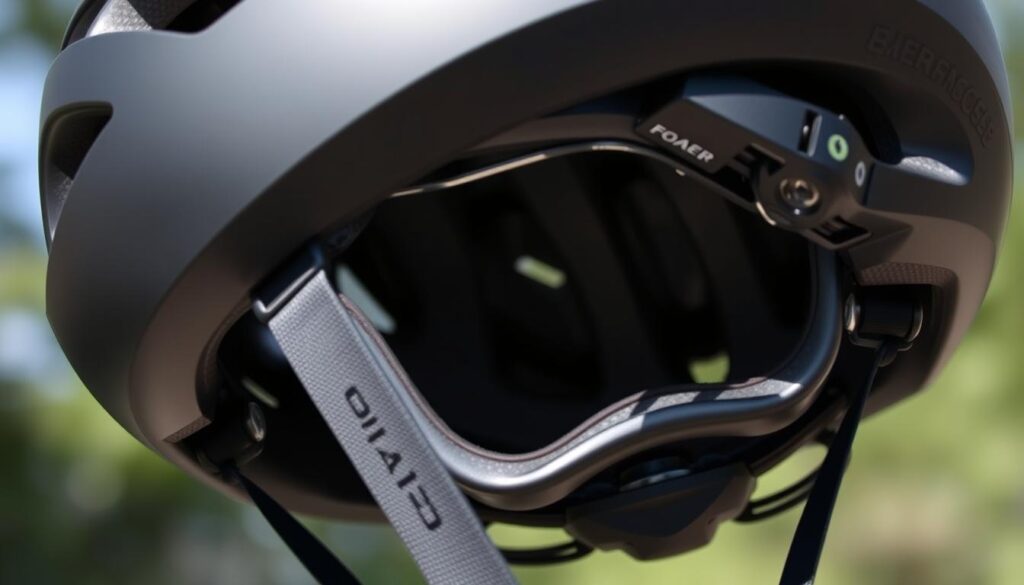
Design Elements: Style, Visor, and Aesthetics
Design plays a crucial role in making e-mountain bike helmets both stylish and functional. A well-designed helmet not only enhances your riding experience but also boosts your confidence on the trails. Whether it’s the sleek outer shell or the integrated visor, every detail contributes to the overall appeal and performance of the helmet.
Integrated Visor Features
Integrated visors have become a staple in modern e-mountain bike helmets, offering both functionality and style. These visors provide protection from the sun, mud, and debris, ensuring clear visibility during rides. For instance, the Giro Manifest Spherical features an adjustable visor that allows riders to customize their coverage12. Similarly, the POC Kortal Race MIPS boasts a sleek, integrated visor design that enhances both aesthetics and functionality13.
| Feature | Details | Examples |
|---|---|---|
| Integrated Visor | Adjustable for customizable coverage | Giro Manifest Spherical |
| Sleek Outer Shell | Robust design for enhanced protection | POC Kortal Race MIPS |
| Colour Schemes | Customised finishes for modern appeal | Giro and POC Models |
Brands like Giro and POC are known for their signature design cues, blending style with safety. Their helmets often feature attractive colour schemes and finishes that appeal to modern riders. These design choices not only enhance the visual appeal but also contribute to the helmet’s safety and aerodynamics.
Sustainable Materials and Eco-Friendly Innovations
Sustainability is becoming a key focus in the manufacturing of e-mountain bike helmets, as brands strive to reduce their environmental footprint while maintaining high safety standards. This shift is driven by the growing demand for eco-conscious products and the cycling industry’s commitment to reducing waste.
Manufacturers like Scott are leading the way by incorporating recycled EPS foam and other recycled components into their helmets14. Similarly, POC’s Myelin helmet is constructed with 50% recycled materials, showcasing how innovation can align with sustainability15. These practices not only conserve resources but also lower production emissions, contributing to a greener future.
Recent models, such as the Verde KinetiCore, highlight eco-friendly features like disassembly for easy recycling and minimal packaging14. POC’s Snap-Fit system, made from recycled polyester, further exemplifies how design can merge with sustainability without compromising performance15. These advancements ensure that eco-conscious riders can enjoy high-quality, environmentally friendly helmets that meet rigorous safety standards.
Pricing, Value and Budget Considerations
When considering an e-mountain bike helmet, the price can significantly influence the features and overall value you receive. The market offers a wide range of options, from budget-friendly helmets that provide essential safety features to premium models with advanced technologies and superior build quality.
Budget-Friendly Helmet Options
For riders on a budget, there are several affordable helmets that deliver excellent value. The Giro Radix MIPS is a great example, priced between $63 and $100, offering strong protection and comfort scores of 8.0 and 9.0 respectively1. Similarly, the Specialized Camber is available for just $35, providing solid all-around performance with an overall score of 771.
Premium Feature Investments
Premium helmets offer cutting-edge features and superior build quality. The Giro Manifest Spherical, priced between $182 and $195, boasts exceptional ventilation with a perfect score of 10.0, making it ideal for long rides1. The POC Kortal Race MIPS is another top choice, available from $199 to $280, featuring outstanding protection and ventilation scores of 10.0 and 9.0 respectively1.
| Helmet Model | Price Range | Key Features |
|---|---|---|
| Giro Radix MIPS | $63 – $100 | Essential safety, MIPS technology |
| Specialized Camber | $35 | Good protection and comfort |
| Giro Manifest Spherical | $182 – $195 | Exceptional ventilation |
| POC Kortal Race MIPS | $199 – $280 | Advanced protection and features |
When choosing a helmet, consider your budget and riding needs. Budget-friendly options provide great value for casual riders, while premium helmets offer advanced features for serious enthusiasts. Always check reviews and ensure the helmet meets safety standards for your region.
Durability and Long-Term Performance
Durability is crucial for helmets that endure extensive use. A robust shell and outer layers play a significant role in longevity, ensuring consistent protection over time16.
Independent ratings highlight the Sweet Protection Trailblazer, which maintains its performance and appearance exceptionally well. Users praise its ability to withstand rough conditions, making it a top choice for long-term use16.
| Feature | Details | Examples |
|---|---|---|
| Robust Shell | Enhances impact resistance | Giro Manifest Spherical |
| Outer Layers | Contribute to longevity | POC Kortal Race MIPS |
| Consistent Protection | Maintains safety over time | Sweet Protection Trailblazer |
Manufacturers often provide spare parts, like replaceable pads, to extend a helmet‘s lifespan. Regular cleaning and proper storage are essential for maintaining both safety and comfort17.
Durability is vital when comparing options. For more on top models, visit Mountain Freak to explore high-performance helmets.
Lightweight Construction and Weight Considerations
When it comes to e-mountain biking, a lightweight helmet can make a significant difference in your riding experience. The balance between a lightweight design and robust protection is crucial, as it directly impacts both comfort and performance. Advanced materials like EPS foam play a key role in achieving this balance, offering excellent impact absorption without adding unnecessary bulk18.
Impact on Ride and Endurance
A lightweight helmet reduces fatigue, allowing riders to enjoy longer adventures without discomfort. For instance, the Specialized Gambit weighs just 21.6 oz (613 grams), making it one of the lightest options available19. Similarly, the Smith Mainline MIPS tips the scales at 27 oz (765 grams), combining low weight with a high level of protection18.
The integration of MIPS technology is another critical factor. While MIPS adds a layer of safety by reducing rotational forces during impacts, it doesn’t significantly increase the helmet’s weight. The Fox Speedframe Pro is a prime example, offering MIPS protection while maintaining a lightweight profile19.
When choosing a helmet, it’s essential to balance weight with other features like ventilation and protection. Riders prioritizing lightweight gear should consider models with advanced materials and efficient designs. Practical tips include trying several helmets to find the perfect fit and considering the terrain you’ll be riding on most frequently.
Selecting the Right Helmet Size: Measuring and Fitting Guide
Choosing the correct helmet size is essential for both safety and comfort. Start by measuring your head circumference just above your eyebrow level20. This ensures an accurate fit, as sizes vary between brands. For instance, POC helmets often have specific size ranges, so checking their sizing chart is crucial21.
When trying on a helmet, it should cover most of your forehead to protect the frontal lobe20. The straps should form a “V” around your ears, and the buckle should sit two finger widths below your chin21. Ensure the fit is snug but not constricting, as a loose helmet can increase injury risk21.
Adjustable visors and secure buckles are key for a perfect fit. POC models, for example, offer adjustable visors for customized coverage22. Test the helmet by gently moving it; it shouldn’t shift more than an inch20. Regular fit checks are important as straps can loosen over time20.
Brand-specific variations mean that while POC might suit some, others may prefer a different brand. Higher-priced helmets often offer more adjustable features for a precise fit20. Remember, the right size and shape can make a significant difference in comfort and safety.
In-Depth User Reviews and Ratings Overview
User reviews and independent ratings provide valuable insights into the performance of e-mountain bike helmets. Riders often highlight comfort, ventilation, and fit as key factors influencing their satisfaction. For instance, the Smith Express MIPS has received praise for its lightweight design and efficient airflow, with a 4.5-star rating across 200 reviews23.
| Helmet Model | Key Features | Rating |
|---|---|---|
| Smith Express MIPS | Lightweight, MIPS technology, 13 vents | 4.5/5 |
| Bern Hudson MIPS | Extended coverage, 13 vents | 4.3/5 |
| Abus Pedelec 2.0 | NTA 8776 certified, 4 inlets, 9 outlets | 4.2/5 |
Common praises include the ventilation systems, with many users appreciating the cooling effect during long rides. However, some helmets, like the Giro Camden MIPS, have been noted for their heavier weight, which can cause discomfort on extended adventures24.
Independent ratings from sites like BikeRadar often align with user feedback, emphasizing the importance of genuine reviews in making informed decisions. For more detailed insights, visit Mountain Freak to explore top-rated models.
Comparative Analysis of Leading Helmet Models
When evaluating the top e-mountain bike helmets, it’s essential to compare their performance, features, and overall value. This section provides an in-depth look at leading models, highlighting their strengths and differences to help you make an informed decision.
Performance and Feature Comparison
Leading brands like POC and Giro consistently deliver high-quality helmets with innovative features. The POC Kortal Race MIPS, for instance, stands out with its advanced ventilation system and robust impact protection25. Similarly, the Giro Manifest Spherical offers exceptional comfort and a sleek design, making it a top choice for endurance rides25.
- Top Models:
- Key Features:
| Model | Price Range | Weight | Key Features | Value |
|---|---|---|---|---|
| POC Kortal Race MIPS | £220 | 370g | NFC, RECCO, MIPS | Premium features for advanced riders |
| Giro Manifest Spherical | £182-£195 | 370g | Exceptional ventilation | Excellent for endurance |
| ABUS Moventor 2.0 MIPS | £130 | 380g | QUINN technology | Mid-range value |
When choosing a helmet, consider your riding style and terrain. For endurance, the Giro Manifest Spherical excels, while the POC Kortal Race MIPS is ideal for those seeking advanced safety features. Each model offers unique benefits, so weigh factors like price, weight, and features to find your perfect match.
Expert Insights and Professional Tester Feedback
Industry professionals and expert testers have shared their detailed assessments of e-mountain bike helmets, highlighting key features and performance metrics. Giro and POC helmets consistently receive high praise for their advanced protection systems and impact resistance26.
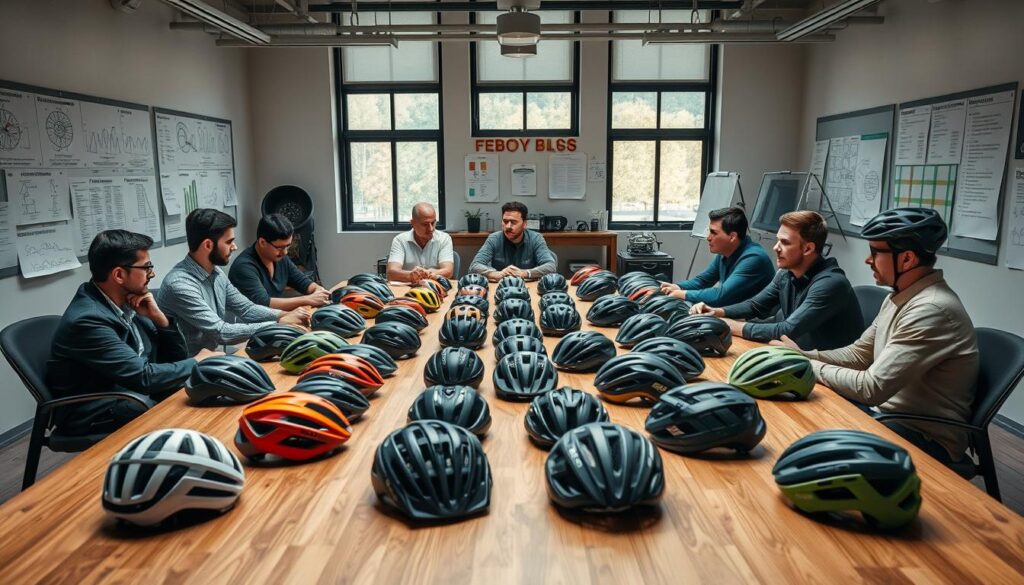
Independent testing plays a crucial role in validating safety claims. For instance, the Lazer Coyote KinetiCore helmet has been noted for its exceptional ventilation and lightweight design, weighing in at 340 grams26. Testers particularly appreciate the integration of MIPS technology, which significantly enhances safety during oblique impacts.
Retention systems are another area of focus. The Smith Network helmet features a secure fit system and a honeycomb-like material called Koroyd, which improves airflow and energy absorption26. Experts emphasize how a snug fit and well-designed buckles contribute to both safety and comfort.
Fit and comfort are also critical. The POC Omne Air Spin helmet is commended for its 360-degree size adjustment system, offering a tailored fit for various head shapes26. One tester remarked, “The integration of MIPS and the overall construction make this helmet feel both secure and comfortable, even on long rides.”
When comparing professional ratings with user feedback, there’s a strong consensus on key features. For example, the Giro Aries Spherical is praised for its ventilation and protection, while the Lazer Lupo KinetiCore offers excellent value for its price point26.
Conclusion
In conclusion, selecting the right helmet for e-mountain biking is a decision that should not be taken lightly. As highlighted throughout this guide, safety and comfort are paramount, with features like MIPS technology and proper ventilation playing a crucial role in enhancing rider protection and experience.
Expert reviews and user feedback consistently emphasise the importance of advanced safety standards and innovative design. For instance, MIPS-equipped helmets like the POC Kortal Race MIPS and Giro Manifest Spherical have received high praise for their ability to reduce rotational forces during impacts, with some models achieving perfect scores in ventilation and protection27.
When making your decision, consider factors such as price, fit, and durability. While premium helmets offer cutting-edge features, mid-range options like the Giro Radix MIPS provide excellent value without compromising on essential safety features. Additionally, always ensure your helmet meets rigorous safety standards like the NTA 8776 certification for higher-speed impacts28.
Avoid helmets priced below €30, as they often fail to provide adequate protection for e-biking28. Instead, invest in a helmet that balances weight and protection, such as the LIVALL Evo21, which weighs just 350 grams and includes innovative features like built-in LED lights and fall detection28.
Ultimately, the right helmet is one that meets your specific needs, whether you’re tackling challenging trails or enjoying leisurely rides. By considering expert ratings, user reviews, and personal fit trials, you can make an informed decision that prioritises both your safety and riding enjoyment.
FAQ
What is MIPS technology and how does it enhance impact protection?
MIPS (Multi-directional Impact Protection System) is a safety feature designed to reduce the rotational force on the head during an impact. It works by allowing the liner to slide slightly inside the helmet, absorbing and redirecting energy. This technology is particularly effective in real-world crash scenarios, offering an additional layer of protection beyond standard EPS foam.
How do I ensure the best fit for my bike helmet?
A proper fit is crucial for both safety and comfort. Measure your head circumference and compare it to the size chart of the helmet. When worn, the helmet should sit level on your head, with the straps forming a “V” shape around your ears. The retention system should be snug but not overly tight, ensuring the helmet stays in place during rides.
What are the key differences between a standard bike helmet and an e-bike helmet?
E-bike helmets often provide greater coverage, especially at the rear and sides, to account for higher speeds and potential impacts. They may also feature enhanced safety technologies like MIPS and improved ventilation systems to manage heat buildup during longer rides.
How important is ventilation in a helmet, and what features should I look for?
Ventilation is vital for comfort, especially on long rides. Look for helmets with multiple, strategically placed vents that create a cooling airflow. Features like internal air channels and breathable padding can also help regulate temperature and prevent excessive sweating.
Can I use a road bike helmet for mountain biking?
While road bike helmets are lightweight and ventilated, they may not offer the same level of protection as mountain bike helmets. Mountain bike helmets typically have greater coverage, especially around the rear and sides, and are designed to handle higher-impact crashes. For off-road riding, it’s best to use a helmet specifically designed for mountain biking.
What does the EPS liner do in a helmet?
The EPS (Expanded Polystyrene) liner is a critical component of a helmet’s safety system. It is designed to absorb and distribute the force of an impact, reducing the pressure on the head. The EPS liner works in conjunction with the outer shell and MIPS (if present) to provide comprehensive protection.
How do I know if a helmet meets safety standards?
Reputable helmets will carry certifications from recognised safety standards such as Snell, ASTM, or EN. These standards ensure the helmet has passed rigorous testing for impact resistance, penetration, and other safety criteria. Always check for these certifications when purchasing a helmet.
Are more expensive helmets always better?
Not necessarily. While premium helmets often feature advanced technologies, superior materials, and better ventilation, there are many affordable options that meet safety standards and provide excellent performance. Consider your riding style, budget, and specific needs when choosing a helmet.
How often should I replace my helmet?
Most manufacturers recommend replacing a helmet every 3-5 years, or immediately after a crash. Over time, the EPS liner and other materials can degrade, reducing the helmet’s protective capabilities. Always check for visible damage or wear before each ride.
What should I look for in a helmet’s coverage and design?
Look for a helmet with extended rear and side coverage for added protection. A rounded shape and secure fit are also important. Features like an integrated visor can provide shade and protect your eyes from debris, while a durable outer shell helps withstand impacts and abrasions.
How do I care for my helmet to ensure longevity?
Avoid exposing your helmet to extreme temperatures, as this can degrade the materials. Clean the helmet with a soft cloth and mild soap, and avoid using harsh chemicals. Store the helmet in a protective bag when not in use to prevent scratches or damage.
Source Links
- The 10 Best Mountain Bike Helmets
- Ride an E-Bike? A Standard Helmet Might Not Cut It
- What Does it Mean for a Helmet to Be eBike Certified?
- Top 10 best e-bike helmets for 2023
- Cycling Helmets Buyer’s Guide: which is best? Tips & Advice
- Best mountain bike helmets reviewed and rated by experts – MBR
- The 7 best e-bike helmets for safety and comfort
- The safest road, mountain bike and urban helmets as rated by Virginia Tech
- What is a Mips Helmet, and Should I Buy One?
- The best mountain bike helmets
- We tested 18 aero helmets in a wind tunnel – here’s what we discovered
- Best mountain bike full face and convertible helmets: Keep a cool head while enjoying next level protection – MBR
- Best Bike Helmets Buying Guide
- Lazer Verde KinetiCore: Taking Helmet Recycling to a New Level
- The world’s first sustainable helmet?
- Lightweight, baby! – 9 lightweight and convertible full-face mountain bike helmets in review
- The Best Mountain Bike Helmets for eBike Riders
- The 7 Best Full Face Bike Helmets of 2025
- Best full face MTB helmets 2024 – top-tier head protection for testing your limits
- How To Size A Bike Helmet | Halfords UK
- Bike helmet sizes explained: how to measure your bike helmet size for a perfect fit
- Bike Helmet Sizing Guide
- Best Ebike Helmets We’ve Tested – Ebike Escape
- Best ebike helmets 2023
- Best mountain bike helmets 2025 – top-rated head protection for the trail
- The 19 Best Bike Helmets of 2024, According to Our Test Editors
- The Ultimate Buyer’s Guide for eMTB Helmets (2023) – Eskute UK
- Best E-Bike Helmets 2025

